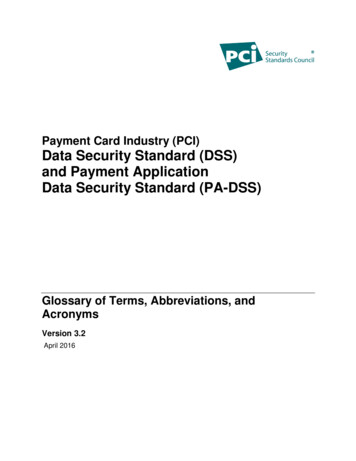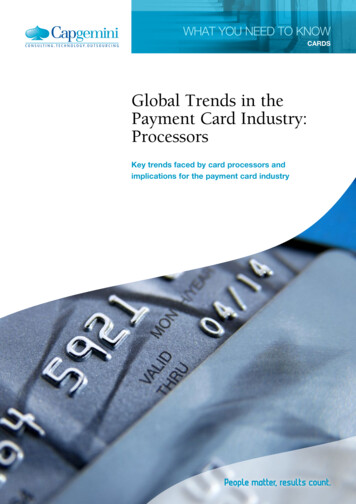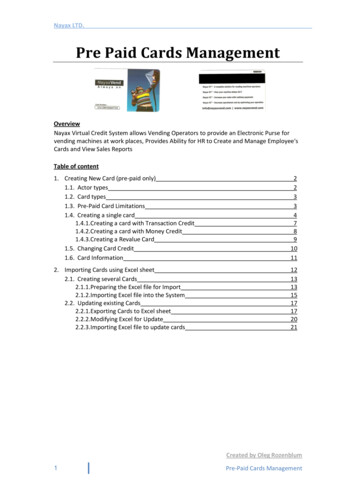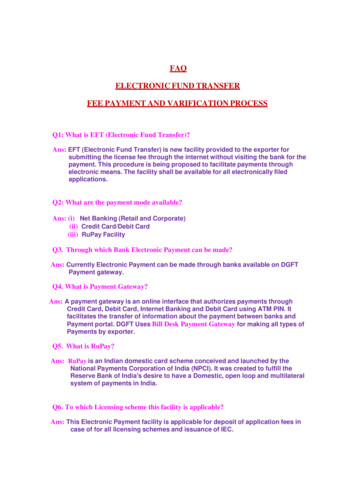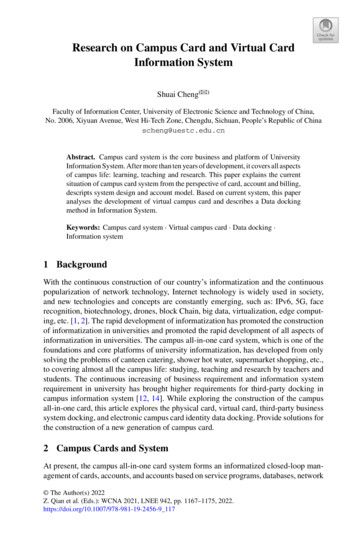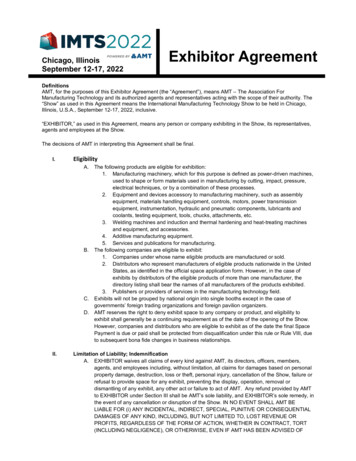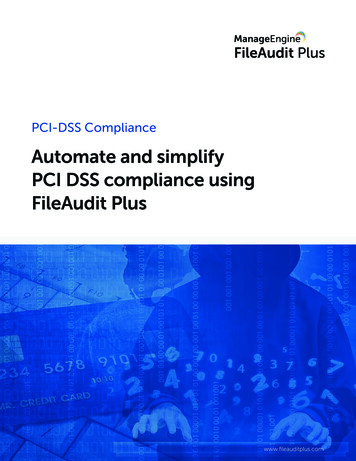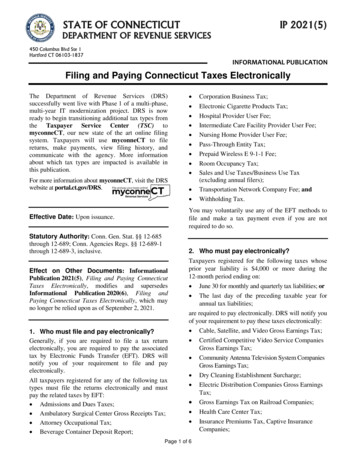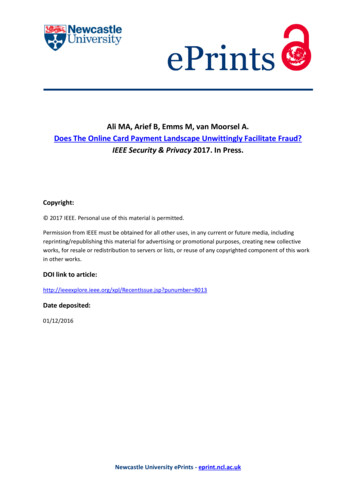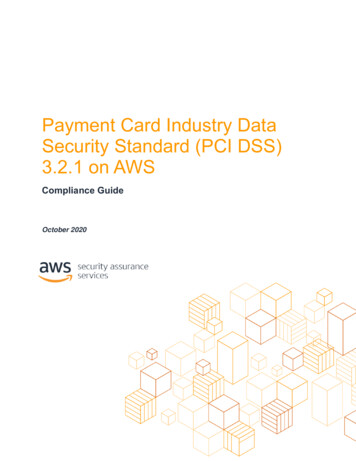
Transcription
Payment Card Industry DataSecurity Standard (PCI DSS)3.2.1 on AWSCompliance GuideOctober 2020
NoticesCustomers are responsible for making their own independent assessment of theinformation in this document. This document: (a) is for informational purposes only, (b)represents current AWS product offerings and practices, which are subject to changewithout notice, and (c) does not create any commitments or assurances from AWS andits affiliates, suppliers or licensors. AWS products or services are provided “as is”without warranties, representations, or conditions of any kind, whether express orimplied. The responsibilities and liabilities of AWS to its customers are controlled byAWS agreements, and this document is not part of, nor does it modify, any agreementbetween AWS and its customers. 2020 Amazon Web Services, Inc. or its affiliates. All rights reserved.
ContentsOverview .1PCI DSS Compliance Status of AWS Services.1AWS Shared Responsibility Model .2Scope and Cardholder Data Environment .3Customer PCI DSS Scope .3Scope Determination and Validation .4Diagrams and Inventories .5Data Flow Diagrams.5Network Diagrams .6System Component and Data Storage Inventories.7Network Segmentation .7Guide for PCI DSS Compliance on AWS .8Requirement 1 .8Requirement 2 .10Requirement 3 .13Requirement 4 .13Requirement 5 .14Requirement 6 .15Requirement 7 .16Requirement 8 .17Requirement 9 .18Requirement 10 .19Requirement 11 .20Requirement 12 .22Conclusion .23Contributors .23
Additional Resources .23Document Revisions.24
About this GuideThe objective of this guide is to provide customers with sufficient information to be ableto plan for and document the Payment Card Industry Data Security Standard (PCI DSS)compliance of their AWS workloads. This includes the selection of controls that meetspecific PCI DSS 3.2.1 requirements, planning of evidence gathering to meetassessment testing procedures, and explaining their control implementation to their PCIQualified Security Assessor (QSA).AWS Security Assurance Services, LLC (AWS SAS) is a fully owned subsidiary ofAmazon Web Services. AWS SAS is an independent PCI QSA company (QSAC) thatprovides AWS customers and partners with specific and prescriptive information on PCIDSS compliance. As a PCI QSAC, AWS SAS can interact with the PCI SecurityStandards Council (SSC) or other PCI QSAC under the confidentiality and contractualframework of PCI.
Amazon Web ServicesPayment Card Industry Data Security Standard (PCI DSS) 3.2.1 on AWSOverviewThe purpose of the PCI DSS is to protect cardholder data (CHD) and sensitiveauthentication data (SAD) from unauthorized access and loss. Cardholder data consistsof the Primary Account Number (PAN), cardholder name, expiration date, and servicecode. Sensitive authentication data (SAD) includes the full track data (magnetic-stripedata or equivalent on a chip), CAV2/CVC2/CVV2/CID, and PINs/PIN blocks.Applications that store, process, or transmit cardholder data must be protected, andrequire careful planning to both implement and demonstrate compliance of all PCI DSScontrols. It is important to note that PCI DSS is not just a technology standard, it alsocovers people and processes. Security and compliance are important sharedresponsibilities between AWS and the customer. It is the customer’s responsibility tomaintain their PCI DSS cardholder data environment (CDE) and scope, and be able todemonstrate compliance of all controls, but customers are not alone in this journey. Theuse of PCI DSS compliant AWS services can facilitate customer compliance, and AWSSecurity Assurance Services team can assist customers with additional informationspecific to demonstrating the PCI DSS compliance of their AWS workloads.PCI DSS Compliance Status of AWS ServicesAWS establishes itself as a PCI DSS Service Provider to enable, upon furtherconfiguration, the compliance of our customers. The scope for each service assessedassumes that any data provided by the customer could include credit card numbers,sensitive authentication data (SAD), or the service could impact the security of theprovided sensitive data. Therefore, AWS services listed as PCI DSS compliant areassessed as if they store, process, or transmit cardholder data on behalf of customers.This includes all physical security requirements for AWS data centers that support thosePCI DSS in scope services.AWS completed a Level 1 assessment as a Service Provider in July 2019. The AWSServices in Scope by Compliance Program (“Compliance Program”) website lists theAWS services that were included in the annual PCI DSS assessment, along with allother services by Compliance Program. This list is updated throughout the year.Customers can access AWS compliance documentation, to include the AWS PCIResponsibility Summary and the AWS Attestation of Compliance (AOC), through theAWS Management Console using AWS Artifact.1
Amazon Web ServicesPayment Card Industry Data Security Standard (PCI DSS) 3.2.1 on AWSAWS Services listed as PCI DSS compliant means that they have the ability to beconfigured by customers to meet their PCI DSS requirements. It does not mean that anyuse of that service is automatically compliant. Customers are responsible for theimplementation of additional controls that may be necessary or applicable.Customers can leverage AWS security, identity, and compliance services to achievePCI compliance of their cardholder data environment by addressing specific requiredsecurity controls. Examples of these include the AWS Management Console and AWSCommand Line Interface (AWS CLI), AWS Identity and Access Management (IAM),Amazon CloudWatch, AWS CloudTrail, and Amazon Time Sync Service.AWS Shared Responsibility ModelSecurity and Compliance is a shared responsibility between AWS and the customer.This shared model can help relieve the customer’s operational burden as AWSoperates, manages, and controls the components from the host operating system andvirtualization layer down to the physical security of the facilities in which the serviceoperates.Figure 1 – Shared Responsibility ModelAWS is responsible for the security and compliance of the cloud, or the infrastructurethat runs all of the services offered in the AWS Cloud. Cloud security at AWS is thehighest priority. AWS customers benefit from a data center and network architecture2
Amazon Web ServicesPayment Card Industry Data Security Standard (PCI DSS) 3.2.1 on AWSthat are built to meet the requirements of the most security-sensitive organizations andcompliance frameworks. This infrastructure is composed of the hardware, software,networking, and facilities that run AWS Cloud services. This includes controls thatmaintain separation between customer resources and data, along with numerous otheradministrative, compliance, and security related controls.Customers are responsible for the security and compliance in the Cloud, or thecustomer configured systems and services provisioned on AWS. Customers areresponsible for the compliant configuration of all system components, to include AWSresources and services, included in or connected to their cardholder data environments(CDE). Customers are responsible for the operating systems and installed applicationson Amazon Elastic Compute Cloud (Amazon EC2), and network routing andconfiguration of associated virtual networking components. For abstracted services likeAmazon Simple Storage Service (Amazon S3) or Amazon DynamoDB, this includescustomer-configurable controls such as access controls, permissions, log settings,encryption settings, and Security Groups. Some Amazon services, like Amazon ElasticContainer Service (Amazon ECS), present a form of hybrid model in which customerscan choose a serverless compute engine in AWS Fargate or run their containers onAmazon EC2 infrastructure. Customers are responsible for the non-abstracted portionof the service and AWS is responsible for underlying infrastructure. AWS Fargate is agood example of this; customers are responsible for the application (container) anddefining networking and IAM policies, but not for the underlying virtual machines andclusters.A good rule-of-thumb is that if a customer can set a particular configuration, they areresponsible for setting it appropriately to meet PCI DSS requirements. AWS iscommitted to helping customers achieve the highest levels of security in the cloud.Scope and Cardholder Data EnvironmentCustomer PCI DSS ScopeThe PCI DSS security requirements apply to all system components included in orconnected to the cardholder data environment. The cardholder data environment (CDE)comprises people, processes, and technologies that store, process, or transmitcardholder data or sensitive authentication data. “System components” include networkdevices, servers, computing devices, applications, and services both inside and outsideof Amazon Web Services’ offerings as applicable. Customers may have systems thatare part of their environment that are not on AWS, for which they retain the3
Amazon Web ServicesPayment Card Industry Data Security Standard (PCI DSS) 3.2.1 on AWSresponsibility of meeting all applicable PCI DSS requirements, such as retail locations,mobile devices, administrative systems in offices, or on-premises systems.A complete and accurate description of business processes and data flows that involvePAN and CHD is the basis for planning and demonstrating compliance. Cardholder datashould be stored and processed in the fewest locations possible, to limit the exposure ofcardholder data to misuse and limit customer assessment scope.Scope Determination and ValidationIt is critical to understand the complete flow of cardholder data within applications andthe environment, including interactions with procedures and application code. The dataflow determines the applicability of the PCI DSS, defines the boundaries andcomponents of a cardholder data environment (CDE), and the scope of a PCI DSSassessment. Accurate determination of PCI DSS scope is key to both customer securitypostures and successful assessments of their environments. Customers must have aprocedure for scope determination that assures scope completeness and accuracy.As noted in PCI DSS, v3.2.1 – “At least annually and prior to the annual assessment,the assessed entity should confirm the accuracy of their PCI DSS scope by identifyingall locations and flows of cardholder data, and identify all systems that are connected toor if compromised could impact the CDE (e.g. authentication servers) to ensure they areincluded in the PCI DSS scope.” It is critical that organizations be able to not onlydescribe their PCI DSS scope within the environment, but also support the Assessor’sability to validate it.An additional consideration for Amazon EC2 instances is that other instances that donot touch cardholder data may be in PCI DSS scope if they have un-segmentednetwork access to instances that do store, transmit, or process cardholder data.Merchants using e-commerce outsourcing services should follow InformationSupplement: Best Practices for Securing E-commerce. E-commerce payments solutionsmay rely on elements, such as JavaScripts, that are stored in the merchants’environment (Section 6.3 Case Study Three: Partially Outsourced). Those resources,such as Amazon S3 buckets or web server instances, are in assessment scope. If themerchant is completing an SAQ, then SAQ-A-EP is likely required.4
Amazon Web ServicesPayment Card Industry Data Security Standard (PCI DSS) 3.2.1 on AWSDiagrams and InventoriesData Flow DiagramsIt is important to detail the flow of cardholder data (and security impacting data) in theapplication to demonstrate that the scope determination process is complete andaccurate. Descriptions and diagrams should specify resource names and not justservices. These details make it clear which resources in the environment are subject toPCI DSS requirements.Here is a sample data flow diagram and associated data flow index:Figure 2 – Sample cardholder dataflow diagramStepCHD t onlyHTTPS on AF listeningports (only 443in this case)StatefulinspectionApplicationattack L thorizationConsumertransactionsent nforwarded toAWS WAF3AuthorizationTransactionforwarded toAPI GatewayTermTLS?5
Amazon Web ServicesStepCHD FlowsPurpose4Payment Card Industry Data Security Standard (PCI DSS) 3.2.1 on tectionAuthorizationTransactionforwarded toAWS Lambdafor ationTransactiondata sent toAmazonDynamoDBPaymentDatabase forstorage oftransactiondetails prior toprocessingPrivateVPCTLSSecurity GroupVPC endpointfor AmazonDynamoDB onprivate VPCAWS APIcredentialsIAM rolesResourcepoliciesPAN,Name,Expiration– ned toAWS Lambdafor transactionprocessingPrivateVPCTLSN/A - responsetrafficPAN,Name,Expiration– ent toPaymentProcessor forauthorization.No CHD isreturned.InternetIPSec VPN3rd partyservice viceproviderdefinedNetwork DiagramsPCI DSS requires that customers maintain current network diagrams. These diagramsare critical to understanding both the scope and function of the CDE. They must showthe boundaries of the networks and environment, all ingress and egress points, andnetwork access controls at the communication points between the CDE and bothtrusted and untrusted networks clearly. Trusted networks are those networks that arecontrolled and assessed by the organization or a compliant service provider. Untrustednetworks are all other networks, including networks external to, or unassessed by, theorganization. These diagrams must also include key in-scope resources andtechnologies, such as AWS WAF or Amazon EC2 instances, and the different subnetsresources reside in. This would also include, but is not limited to, items such asdemarcation points, adjacent out-of-scope networks, all Security Groups protecting theCDE, and virtual private clouds (VPC). Customers have the option of incorporating allitems into a single comprehensive high-level network diagram, or maintaining separatehigh-level and detailed network diagrams that incorporate the different requiredelements.6
Amazon Web ServicesPayment Card Industry Data Security Standard (PCI DSS) 3.2.1 on AWSFor example network diagrams, see Standardized Architecture for PCI DSS on theAWS Cloud Quick Start.System Component and Data Storage InventoriesCustomers must be able to identify and list all types of critical hardware and software inuse in their cardholder data environment. For AWS environments, this list includes AWSresources that implement application functions, security controls, or management forthe environment. Inventories of critical hardware and software in use should includeanalogous information for the vendor (AWS), make/model (service name), the name ofthe software product and version or release (if there are selectable options for theservice, such as RDS MySQL), and the role or functionality provided (specific resourcename). Much of this information can be pulled directly from AWS with AWS Config andAWS Systems Manager, or even the AWS Application Discovery Service. Cardholderdata inventories must include all databases, tables, and files storing pre- and postauthorization cardholder data as applicable. Third party tools can also be useful forinventory collection. The details that must be captured with regard to cardholder datastorage include the following information: Data store name (e.g. AWS Service, resource, database) Specific files or tables containing CHD The CHD elements stored (e.g. PAN, expiration, name) Security details (e.g. encryption type and strength, tokenization, accesscontrols, truncation) Logging details (e.g. describe the log management solution, application-levellogging, or AWS Service receiving log data)Network SegmentationNetwork segmentation is an important security control for safeguarding CHD, and canlimit the scope of a customer’s CDE and PCI DSS assessment. Network segmentationis not a requirement, and many assessors may not be familiar with AWS networksegmentation methods. It is important to list all mechanisms in place, both those usedby applications and those provided by AWS. For more in-depth information aboutnetwork segmentation and PCI DSS scope, see Architecting for PCI DSS Scoping andSegmentation on AWS.Note that network segmentation may require filtering at the Application Layer of the OSInetworking model. This layer is typically not in the scope of network devices and7
Amazon Web ServicesPayment Card Industry Data Security Standard (PCI DSS) 3.2.1 on AWSresources and is implemented in application code or configurations. Examples of thisare: Identity and Access Management settings Database permissions Application or service API authentication and access control Code to ensure CHD is detected and blocked from external API calls Integration middleware server configuration and permissionsGuide for PCI DSS Compliance on AWSRequirement 1Amazon Network BorderAmazon implements a border architecture that distributes and independently scalesmany of the features combined into typical firewalls, and provides several services thatcan help support the firewall, router, and network segmentation requirements of PCIDSS: Amazon Virtual Private Cloud (Amazon VPC), Amazon EC2 Security Groups, andVPC Network Access Control Lists (NACLs), and AWS Identity and AccessManagement (IAM). This distributed firewall functionality for all incoming traffic isassessed as part of the AWS PCI DSS assessment.Amazon EC2 networking features include a mapping service, which performs checks toensure that packets with malformed or modified addresses cannot cross Amazon VPCboundaries, and satisfies the Requirement 1.3.3 for customer VPC-hostedenvironments. Traffic received by public Elastic IP addresses is routed on to theAmazon EC2 network, and therefore is subject to inherent, assessed network controls,before it is received by Amazon EC2 instances.Amazon VPC lets customers provision a logically isolated section of the AWS Cloudwhere they can launch AWS resources in a virtual network that they define. SecurityGroups act as a stateful firewall for resources within an Amazon VPC, controlling bothinbound and outbound traffic at the virtual network interface. Security Groups can beused to restrict traffic by IP address, port, and protocol, and satisfy elements of PCIDSS Requirements 1.1, 1.2, and 1.3. Note that by default, Security Groups allow alloutbound connections; customers are responsible for configuring specific outboundconnection rules for PCI DSS compliance. Network access control lists (ACLs) are an8
Amazon Web ServicesPayment Card Industry Data Security Standard (PCI DSS) 3.2.1 on AWSoptional layer of security for VPCs that acts as a stateless router for controlling traffic inand out of one or more subnets. Customers can utilize IAM can evaluate and denytraffic based on the connection source, whether in standard CIDR IPv4 or IPv6 format orspecific AWS resources and provide traffic filtering above layer 4 of the OSI model.VPC Endpoints are a feature of Amazon VPC that enable customers to connect tosupported AWS services using private IP addresses on their own VPC. VPC endpointservices are powered by AWS PrivateLink. This traffic does not leave the AWS networkand does not require internet access or public IP addresses to communicate withresources exposed with VPC endpoints. AWS APIs use TLS, by default, for encryptingdata transmitted to endpoints, so creation of this private network path is not necessaryfor compliance. However, VPC Endpoints are useful for designing PCI DSS compliantnetworks because they simplify demonstrating that data between Amazon VPCresources and AWS services does not traverse open, public networks under PCI DSSRequirements 1.3.4.Abstracted Service Network SegmentationAmazon Web Services provides network segmentation and abstraction for services byway of APIs, service endpoints, and VPC endpoints. APIs and endpoints, both publicand private, used for abstracted services do not create a persistent “connection” fromthe CDE to the service, and do not extend PCI DSS scope. An API or endpoint initiatesa data exchange with a service; the services do not themselves initiate connections ordata requests. This means that abstracted services are in-scope for a customerassessment only if the customer explicitly uses that service to store, process, ortransmit cardholder data, or the service directly affects the security of the customercardholder data environment.AWS Service Endpoints are web services interfaces with public IP addresses that arefully the security and compliance responsibility of AWS. They are assessed for all PCIDSS requirements as part of the AWS assessment. Customers can be assured thatthese AWS service API endpoints are compliant network boundaries between untrustedand trusted networks and segmentation within trusted networks (e.g. between a DMZand internal network). Customers can leverage AWS endpoints and APIs, such asAmazon CloudFront or Amazon API Gateway, to satisfy Requirements 1.3, 1.3.1, 1.3.2,and 1.3.6 for implementing a DMZ and prohibiting direct public access when placed “infront” of customer VPC resources such as Amazon RDS and combined with appropriateIAM restrictions and any other appropriate security controls.9
Amazon Web ServicesPayment Card Industry Data Security Standard (PCI DSS) 3.2.1 on AWSPCI DSS requirement 2.2 requires that Customers are aware of and follow vendorsecurity guidance, such as ensuring secure use of AWS API security features, forinstance, AWS Access Keys and signed requests.For abstracted services that transmit CHD over public networks, it is critical to ensurethat only TLS 1.1 or higher is used. Customers should configure this by using clientconfigurations to initiate a handshake with AWS that specify TLS 1.1 or higher. Notethat not all configurations of TLS 1.1 use strong cryptography. NIST SP800-52 hasdetails on TLS configuration. For a complete discussion of network segmentation forPCI DSS scope, see Architecting for PCI DSS Scoping and Segmentation on AWS.1.1 Firewall and Router StandardsCustomers are responsible for the documentation of their AWS hosted networkinfrastructure, as well as the approval and testing of related changes. Amazon WebServices provides firewall functionality to protect all resources; it is the customer’sresponsibility to architect their infrastructure to satisfy Requirement 1.1.4.c.1.2 Firewall and Router ConfigurationsCustomers are responsible for the configuration and management of their SecurityGroups and NACLs under this requirement, as well as VPC networking componentssuch as Route Tables or Internet Gateways. The AWS Firewall Manager is a securitymanagement service that can assist customers to centrally configure and managefirewall rules across customer accounts and applications. AWS Firewall Manager canassist customers in demonstrating compliance with Requirements 1.1.7.b, 1.2.2.a, and1.2.2.b.Requirement 22.1 Change Vendor DefaultsCustomers are responsible for changing all vendor-supplied defaults in any third-partysoftware and code incorporated into their AWS environments. AWS services do nothave default accounts or credentials. Customers must provision the access they desireusing IAM, Amazon Cognito, AWS Directory Service, or other authorization mechanism.Customers are generally responsible for configuring operating system level access toEC2 instances. AWS generates unique passwords for the administrator or rootaccounts, and encrypts these credentials using customer-specific private keys whenstarting an EC2 instance to support compliance with Requirement 2.1.10
Amazon Web ServicesPayment Card Industry Data Security Standard (PCI DSS) 3.2.1 on AWS2.2 Configuration StandardsCustomers are responsible for maintaining the security configuration standards for theirresources provisioned on AWS. These standards must be consistent with industryaccepted system hardening standards, and include the customer’s configuration ofAWS services. AWS has published extensive security guides for the platform andindividual services. The base set of these are: Center for Internet Security (CIS) Benchmark for AWS CIS Benchmarks for EC2 instance types AWS Trusted Advisor AWS Security Best Practices AWS Security Checklist AWS Well-Architected Framework: Security PillarAdditional AWS secure configuration standards support is available on the SecurityResource page and in AWS service-specific documentation.Customers leveraging Amazon EC2 have multiple options to address their responsibilityunder this PCI DSS Requirement: AWS managed instances can be used to deliver customer-defined services oninstances fully managed by AWS, but dedicated to the customer and launchedon EC2 resources. These include Amazon RDS, Amazon ECS, Amazon EKS,and Amazon EMR. For AWS-managed instances, AWS is responsible for theconfiguration, maintenance, access control, and logging of the underlyingsystem components that support the service. The customer-configurableelements of these services, such as RDS access control and logging, must beconfigured properly by customers to be compliant. Customer-managed instances are completely configured by the customer;customers are responsible for compliance of all configurations and functions atthe operating system, network, and application layers. Customers should followvendor guidance, industry best practices, and recommendations from AWS forsystem hardening, and are responsible for the secure configuration. Customerdefined instances also includes Amazon Machine Images (AMIs) sourced fromthe AWS Marketplace. The AWS Marketplace offers pre-configured AMIs byAmazon Partner Network (APN) partners that have been hardened by securityprofessionals to meet PCI DSS standards.11
Amazon Web ServicesPayment Card Industry Data Security Standard (PCI DSS) 3.2.1 on AWSAWS offers other services that do not store, process, transmit, or directly affect thesecurity of cardholder data, but can assist customers in managing system componentsin the cardholder data environment. AWS Config is a fully managed service thatprovides an AWS resource inventory, configuration history, and configuration changenotifications to enable security and governance. AWS Config Rules enable automaticchecks of AWS resources configurations recorded by AWS Config. Customers canleverage AWS Config to ensure resources stay in a securely configured state, and areresponsible for managing their permissions configured within the service. Customerscan also use AWS Managed Services (AMS) to operate their AWS resources on theirbehalf i
to plan for and document the Payment Card Industry Data Security Standard (PCI DSS) compliance of their AWS workloads. This includes the selection of controls that meet specific PCI DSS 3.2.1 requirements, planning of evidence gathering to meet assessment testing procedures, and explaining their control implementation to their PCI
